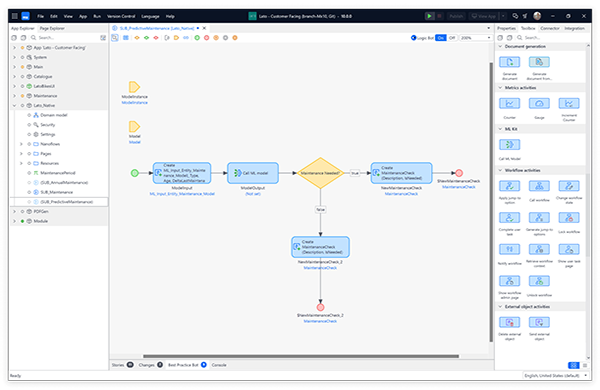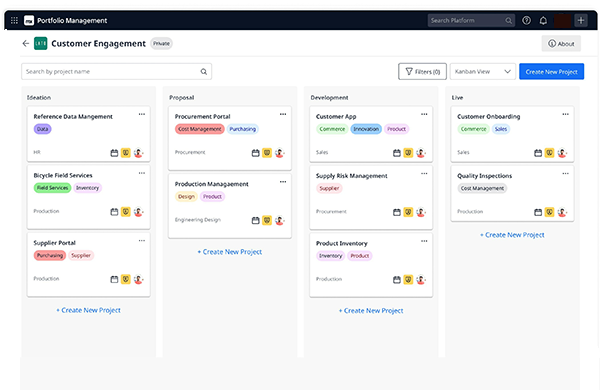AuraQ has vast experience helping organisations find the gaps that can be filled to enhance their business. This could be to improve efficiency, integrate legacy systems or deliver new portals and strategic applications to create competitive advantage. Contact us to request a free, no obligation Gap Analysis.
A deep dive into the low-code phenomenon
Low-code development has been gaining prominence amidst emerging technological solutions. The digital transformation era we live in today is a time of rapid technological advances and within this Digital Age, businesses are constantly grappling with digital disruptions and an increasing demand for software applications. This is where low code emerges as a revolutionary approach to software development, helping empower businesses by equipping them with the tools they need to meet the demand for software solutions. By making the task of building software more accessible to a broader audience, who don’t necessarily need a technical or coding background, low-code platforms are a game changer in the tech industry and there has been an unprecedented uptake in recent years. This trend is set to continue with a predicted 70% of new applications using low-code or no-code technologies by 2025 – up from less than 25% in 2020 (Gartner).
What is Low-Code Development?
The focus on visual development and a drag-and-drop interface is central to the concept of low-code. Unlike traditional coding, which relies heavily on intricate lines of script, low-code platforms present users with a more user-intuitive and model-driven interface that allows users to automate every step of the application lifecycle. The speed in which solutions can be developed using low-code development platforms has seen them emerge as a key strategy to accelerate app delivery to support digital business transformation and found by Forrester to have the potential to make software development as much as 10 times faster than traditional methods.
Through drag-and-drop functionality and pre-built components, individuals can design and configure applications visually without the need for extensive coding expertise. This not only streamlines the development process but also allows users without technical expertise, such as business users, analysts, and other non-technical stakeholders, to contribute to application development and build value-driven enterprise business applications. The versatility of low-code technology allows its adoption across a wide array of industries, from finance to healthcare, education, and manufacturing. For businesses looking to adopt low-code, it is important to understand where low-code fits into your business strategy in today’s digital landscape and the advantages of what it delivers.
Empowering Business Users
Low-code platforms empower business users in departments outside of IT to actively participate in the development process. This democratisation of application development leads to better alignment between technology solutions and business goals.
The nature of low-code also means everyone is speaking the same development language, encouraging better communication and a stronger business-IT partnership. This makes low-code a perfect solution for businesses that are looking to streamline development processes and reduce delivery time.
Visual Appeal and Collaborative Nature
At the heart of low-code is an intuitive visual UI, which goes a long way in simplifying the development process. Rather than a technical coding environment, a model-driven environment lets you visualise how the application works as it’s being built with the ability to launch with one-click deployment.
Furthermore, low-code platforms encourage collaboration between business stakeholders and developers. When business analysts or other users with minimal coding experience are able to participate in application development, they can translate their insights and expertise into software solutions directly, without relying on, for example, DevOps teams. This leads to a more efficient and dynamic development cycle, with quicker feedback loops and improved alignment between the business and IT.
Quicker Development, Cost-Effectiveness, and Accessibility
Another primary advantage of low-code is the speed at which applications can be developed. In contrast with traditional techniques, low-code platforms can help with the rapid creation of prototypes and functioning applications in a fraction of the time. In fact, low-code has the potential to reduce development time by up to 90%. This is especially crucial as organisations struggle to keep up with the increasing demand for software development.
This expedited development cycle not only saves time but also reduces costs significantly as it requires fewer resources. By streamlining the application development process, organisations can allocate resources more efficiently. This way, low-code has been a key solution to bringing application ideas and developments to life with a limited budget and time constraints. This has also opened doors for smaller businesses and startups to embrace application development and other more complex IT strategies that were once unreachable.
Increasing Business Agility
Core to the low-code development process is the Agile methodology. The Agile approach means that software development is more iterative, responsive, and fluid. With a focus on high levels of communication and quick and effective responses to change, solutions can be adapted as they are built in small increments (sprints) with the idea that at the end of each sprint, progress in the form of working software can be demonstrated to stakeholders for feedback.
Agile also means there is frequent and continuous testing throughout the development cycle which allows for quick responses to evolving business needs. The end result is a solution that is developed 100% fit for purpose and the risk of failure is much reduced with the probability of delivering good outcomes to both users and the business greatly increased.
AuraQ’s Services
As technology continues to develop at a rapid pace, the low-code revolution is reshaping the way businesses approach software development. All of the above make low-code a powerful tool for organisations across industries and while it is a tool for both the business and IT, there are still clear advantages of engaging with an expert services delivery partner to elevate your low-code development journey.
Here at AuraQ, as early adopters of the low-code development methodology, we have extensive experience delivering bespoke low-code solutions. So while low-code does provide the business with a simplified development environment, it is important to also recognise that low-code also offers a sophisticated toolbox tailored to support client-side, server-side, and integration development. These more complex applications often require the services of an expert delivery partner to aid with the overall development process and by engaging with professional developers, organisations can deliver even more benefit by extending applications with custom code, integrating data from multiple sources, building mobile applications, leverage microservices, and translating business needs into custom solutions.
Whether you are new to low-code development, or experienced and looking for resources to support your initiatives, AuraQ is happy to assist your business on your low-code journey. Interested to talk to us about our skills and experience further? Reach out to us to learn more!












